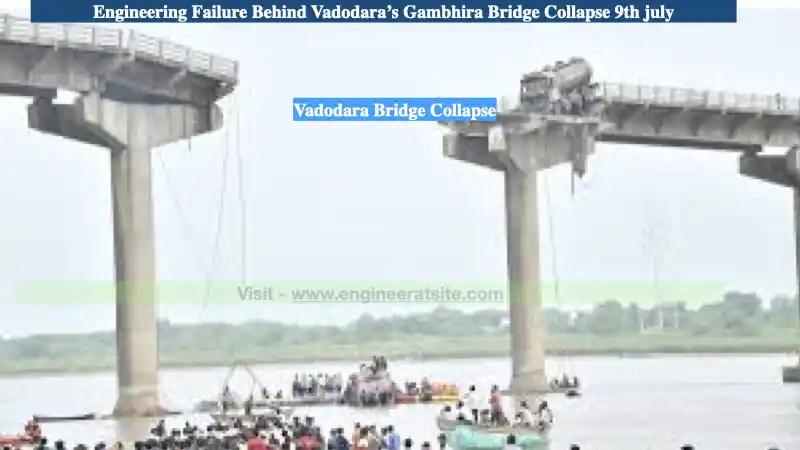The Shocking Incident That Shook Gujarat
Vadodara’s Gambhira Bridge Collapse – The Gambhira Bridge in Vadodara collapsed, sending vehicles into the Mahisagar River and claiming 10 lives. As civil engineers, this tragedy hits close to home—it’s a stark reminder of what happens when engineering oversight fails. Let’s dive into the technical aspects that likely contributed to this disaster.
- The Shocking Incident That Shook Gujarat
- Ageing Infrastructure: A 40-Year-Old Warning
- Design and Load-Bearing Concerns
- Maintenance Missteps: Repairs That Failed
- Lessons for Indian Engineers
Ageing Infrastructure: A 40-Year-Old Warning
The bridge, built in 1985, was a 40-year-old structure carrying heavy traffic. For engineers, this raises red flags. Concrete and steel degrade over time due to corrosion, fatigue, and environmental stress, especially in India’s humid climate.
Local reports of the bridge “shaking dangerously” suggest structural instability, possibly from weakened supports or foundation erosion.
Periodic repairs were attempted, but were they enough? This incident urges us to question the adequacy of maintenance schedules on ageing infrastructure.
Design and Load-Bearing Concerns
A critical engineering aspect is the bridge’s load-bearing capacity. The collapse of one of its 23 spans indicates it may have exceeded design limits.
Heavy vehicles like trucks could have overstressed the ageing framework, especially if the original design lacked modern safety margins.
Eyewitness Narendra Mali noted multiple vehicles falling “one after the other,” hinting at a cascading failure, where one span’s collapse triggered others.
As professionals, we know retrofitting old bridges with updated load assessments is non-negotiable.

Maintenance Missteps: Repairs That Failed
Significant funds were spent on repairs before the collapse, yet the bridge gave way. This points to potential flaws in execution—substandard materials, poor workmanship, or inadequate quality control.
Corrosion of reinforcement bars or improper joint sealing could have compromised integrity. The state’s promise of a new bridge was in progress, but keeping the old one operational during this transition reflects a risky judgment call.
For us in the field, this underscores the need for rigorous QA/QC checks during repairs.
Lessons for Indian Engineers
This tragedy is a wake-up call. As civil engineers, we must advocate for regular structural health monitoring using tools like sensors or drones, affordable options gaining traction in India.
Replacing outdated designs with seismic-resistant structures is vital, given Gujarat’s earthquake-prone zone.
The investigation ahead will reveal more, but for now, let’s honour the lost by ensuring our projects stand strong. Let’s collaborate, innovate, and build a safer future
| For more Job Updates | Click here |
| Follow us on LinkedIn | Click here |
| Follow us on Facebook | Click here |
| Follow us on Twitter | Click here |
| Join on WhatsApp | Click here |
